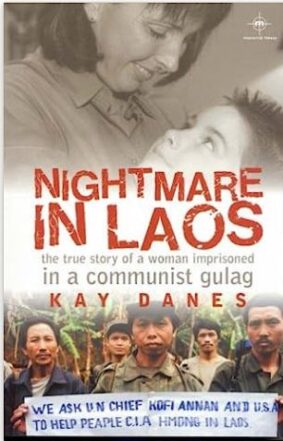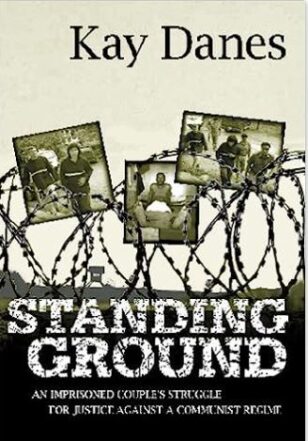Book Reviews
Nightmare in Laos: The True Story of a Woman Imprisoned in a Communist Gulag
By Kay Danes
Maverick House Publishers (January 1, 2006)
303 pages
Standing Ground: An Imprisoned Couple’s Struggle for Justice Against a Communist Regime
By Kay Danes
New Holland Publishers
(March 1, 2009)
400 pages


By Marc Yablonka
Originally published in the Hmong Daily News on July 6, 2023
https://hmongdailynews.com/nightmare-in-laos-relived-p552-120.htm
NIGHTMARE IN LAOS RELIVED
I have long known that Laos, after the secret war ended in 1975, became one of the most corrupt and dangerous countries in the world. I got a sense of that danger when, in 1990, I reported from Vientiane on the state of the Catholic Church in Laos for the National Catholic Register.
A few years later, a “highly-placed” American friend, whom I coincidentally met in the Laotian capital when he was laying plans for a joint venture between himself, his investors, and the Lao government for Vientiane’s first three-star hotel since the end of the Vietnam War, was thrown out of the country at the point of a gun, his entire financial investment absconded with by the Pathet Lao government.
I thought Laos could never get more perilous for a westerner than that…until I read globetrotting humanitarian Australian Professor Kay Danes’ book Nightmare in Laos: The True Story of a Woman Imprisoned in a Communist Gulag (Maverick House Publishers, Ireland, pp. 303, $5.29 from Amazon).
Nightmare in Laos, published in 2006, and its revised edition, Standing Ground (New Holland Publishing Australia, Ltd, 2009, Kindle $9.99) describe in the most vivid and horrific detail possible how Kay and her husband Kerry, a soldier with Australia’s special forces unit, SAS (Special Air Service), then managing the Laos office of the British security firm Securicor, which protected Australian businesses in the country, were thrown into Vientiane’s infamous Phonthong Prison. They languished there for an entire year, between 2000 and 2001, on completely trumped-up charges, revolving around a sapphire mining company they provided security for.
“My days and nights were filled with constant fear because I was living in an uncertain dream,” wrote Kay.” But there were prisoners who had never put their face to the sun as I had, or felt the green leaves of the trees brush against their skin.”
The prison structure itself resembled hell on earth.
“Two prison blocks stood side by side, separated by two large concrete sewage tanks,” Kay wrote. “All the human waste went down the squat style toilet into the large concrete tanks, but the pipes were cracked, so the waste flooded underneath the cells.”
The torture, repeated beatings in attempts to gain confessions from both Kay and Kerry for a crime they did not commit (absconding with sapphires and several thousand dollars) continued for most of the year they were locked up in Phonthong. And they were not the only ones to have suffered thus.
“Our captors locked some prisoners away in darkness for indefinite periods. Time, it seemed, had no relevance in these small cells (0.5 m X 1 metres) they called the `Dark Room.’”
“Every prison in Laos had at least one dark room, and those that went there barely survived. Or if they did, they were never the same again. The dark room was a place where wills were broken,” she wrote.
It was not only in the dark room where torture occurred. In Nightmare in Laos, Kay describes her husband Kerry’s horrific interrogations:
“The police put a plastic bag over his head and almost suffocated him. Another time, they stood on the wooden blocks secured around his ankles and nearly broke them both. When he refused to sign his false statements [always in Lao, which he could not read], they beat him. They pushed him to his knees and wrenched his arms up behind him,” she wrote.
Kerry never broke, for “it was all about control,” which he had learned in his special forces training, and which he had advised Kay.
In a very twisted way, Kay feels grateful to the prison for one thing.
“I learned so much in Phonthong Prison that I would never have learnt on the outside. The secret genocide of the Hmong was something no one ever mentioned. In fact, most Laotians we had worked with had never so much as mentioned the word `Hmong,’” she revealed in Nightmare in Laos.
“I sat with political prisoners who, allegedly, did not exist, and yet they lived and breathed the same foul air as I did. I learned from them things I never knew before,” she wrote about her Hmong cellmates.
Kay further enlightened about her compassion for the Hmong.
“Like many Hmong who had left Laos, there was no Embassy to support them if they got into a problem. They were a people without a country, displaced. How terrible to imagine life like that. To be stuck in a country governed by a regime that didn’t care if you lived or died.”
After months of communist physical and mental abuse, Kay and Kerry were allowed periodic consular visits from the Australian Embassy, which tried every possible desperate measure to free them while their captors continued to play a game that could only be described as extremely cruel.
Phone calls to their children back home followed. Phone calls that tore at everyone’s heartstrings. Everyone, that is, except their sadistic captors’, of course.
Kay described their first call thusly:
“My world spun as I heard our eldest daughter’s voice for the first time in months…I listened to the heartbreak in my children’s voices as they took turns to tell me how they were. I listened and I cried because they cried…the tears like torrents ran down my cheeks,” she wrote.
There was so much more that Kay wanted to tell them, but with her and Kerry’s captors’ mere feet away; she dared not.
“I wanted to tell my family everything I’d seen and endured. I wanted them to know that they locked us in cages, mocking us through the bars.”
She wanted to tell them about “the endless suffering that filled my days. I wanted to tell them that the blue sky shone above me when they let me outside my cell, but the birds that flew overhead only reminded me of how much I longed to be free.”
After months of languishing in prison, in June 2001, Kay and Kerry finally got the Lao version of their “day in court.” However, it hardly resembled that which is afforded prisoners in democratic countries worldwide.
They were sentenced to four years in prison for embezzlement of state assets, and three additional years for destruction of evidence, and also charged with tax evasion. That in spite of a 317-page book that had been prepared by their defense. A book that was never even perused by the three judges who presided over their trial. In addition, Kay was ordered to pay a US$66,847 fine for the supposed “tax evasion.”
After worldwide press coverage of their capture and kangaroo court trial, months of wrangling between the Australian and Lao governments, complete with veiled threats on the part of Australian diplomats that the good relationship the two nations enjoyed might be damaged, in November of 2001, Kay and Kerry Danes left Laos for their Australian homeland.
Though the Danes’ ordeal ended 22 years ago, it’s quite safe to say that it stays with them to this day. Readers will be moved to suffer along with them in both of Kay’s books on the subject.
Post Script: In a recent LinkedIn message I received from Kay, she informed me of something I never knew until reading Nightmare in Laos. That she and Kerry knew my “well-placed” American friend, too! But chose only to identify him by his first name.
Why? Because he endeavored to assemble a group of ex-CIA agents to rescue them from Phonthong Prison. Unfortunately, our mutual friend passed away before the mission could ever be carried out.
ABOUT THE AUTHOR — Marc Yablonka is a military journalist whose reportage has appeared in the U.S. Military’s Stars and Stripes, Army Times, Air Force Times, American Veteran, Vietnam magazine, Airways, Military Heritage, Soldier of Fortune and many other publications. He is the author of Distant War: Recollections of Vietnam, Laos and Cambodia, Tears Across the Mekong, and Vietnam Bao Chi: Warriors of Word and Film.
Between 2001 and 2008, Marc served as a Public Affairs Officer, CWO-2, with the 40th Infantry Division Support Brigade and Installation Support Group, California State Military Reserve, Joint Forces Training Base, Los Alamitos, California. During that time, he wrote articles and took photographs in support of Soldiers who were mobilizing for and demobilizing from Operation Iraqi Freedom and Operation Enduring Freedom.
His work was published in Soldiers, official magazine of the United States Army, Grizzly, magazine of the California National Guard, the Blade, magazine of the 63rd Regional Readiness Command-U.S. Army Reserves, Hawaii Army Weekly, and Army Magazine, magazine of the Association of the U.S. Army.
Marc’s decorations include the California National Guard Medal of Merit, California National Guard Service Ribbon, and California National Guard Commendation Medal w/Oak Leaf. He also served two tours of duty with the Sar El Unit of the Israeli Defense Forces and holds the Master’s of Professional Writing degree earned from the University of Southern California.
Dear Marc,
Thank you for taking the time and care to write this review. The impact of those events has remained with us even after so many years have passed. Nonetheless, we have much to be grateful for. Despite the elaborate lies our captors spun in an attempt to ensure everyone believed us to be guilty of something, our government never gave up on us. This was largely due to the efforts of our family, our ambassador, and people who saw beyond the smoke and mirrors, and especially those in our Special Forces family who refused to let those evil doers take our freedom forever, lest we become lost in time like thousands of others who endure, even today, enforced disappearance. Sadly, the Laos Government still maintains hundreds of secret prisons across the country and refuses to allow UN or Red Cross inspectors access to these prisons so that people might be accorded the right to be treated with dignity, among other rights described by the UN Declaration of Human Rights, to which Laos is a signatory. Your voice is powerful, and I hope that it will inspire further change in Laos, and in other countries like it that continue to pay lip service to democracy, in order to gain access to the wealth of financial aid that comes with being a signatory to international treaties. I am proud to be a member of the Special Forces community, something I will always value. I am stronger in my own mental health for being a part of that community, and the connection I have with those who teach me every day how to be my most resilient self. Again, I thank you for sharing this part of our story. I hope that it inspires others who may feel challenged by life’s ups and downs.
It was my honor Kay!